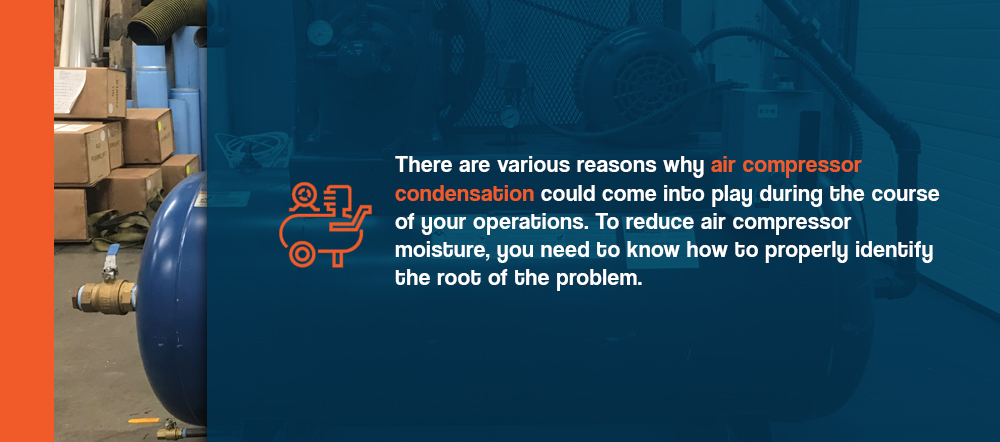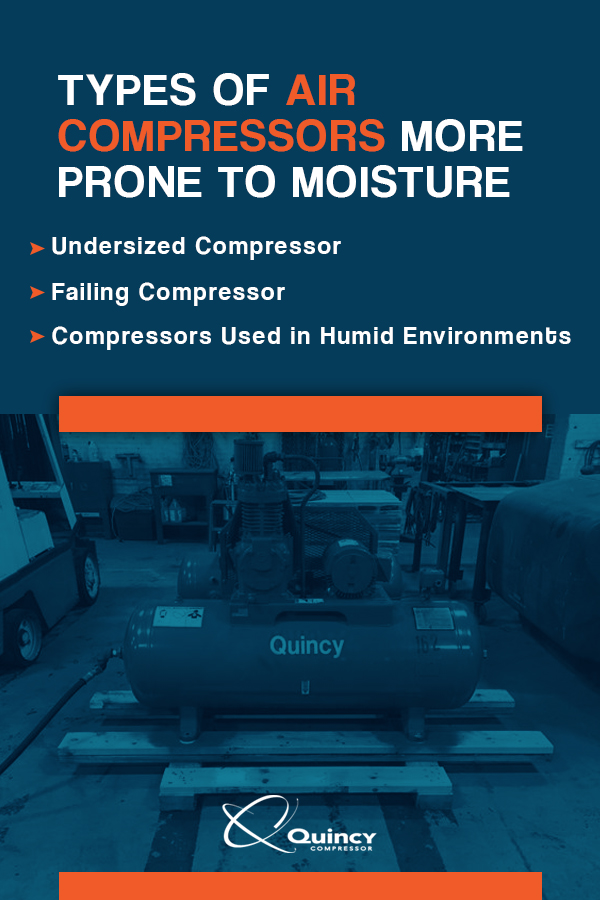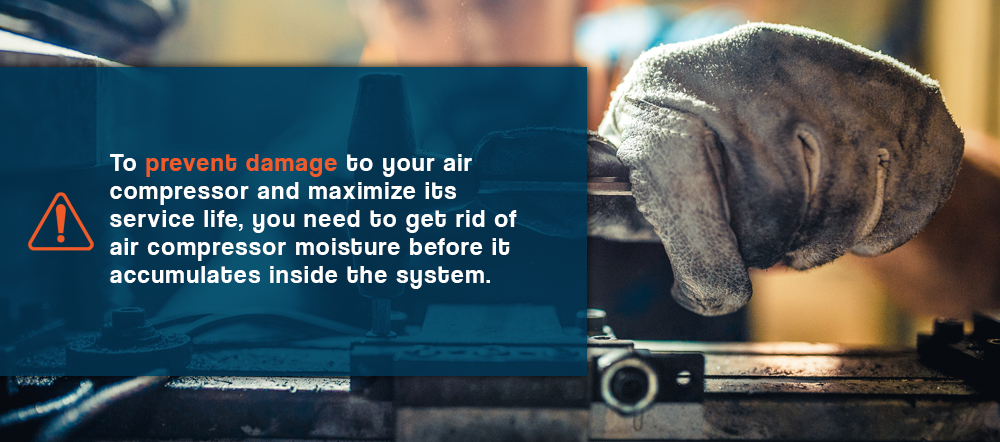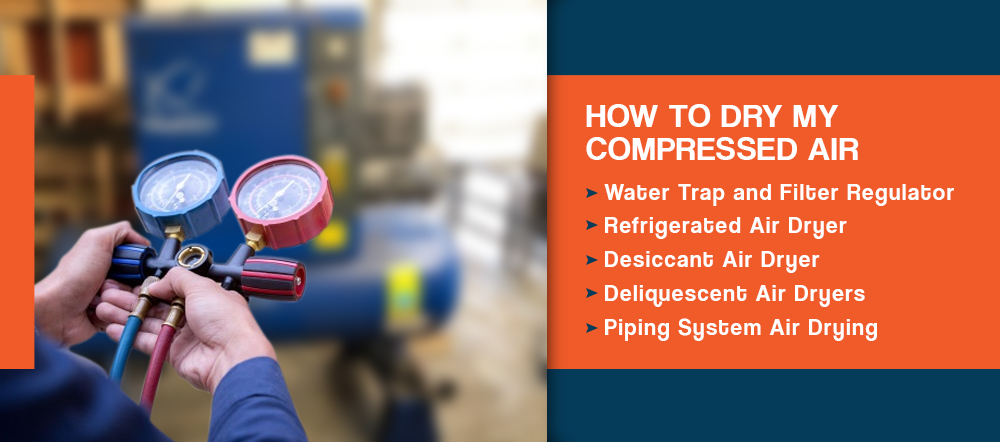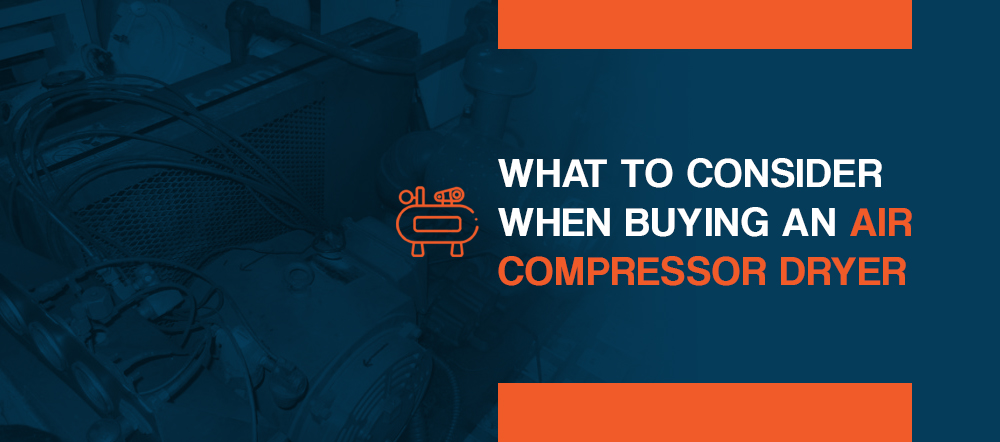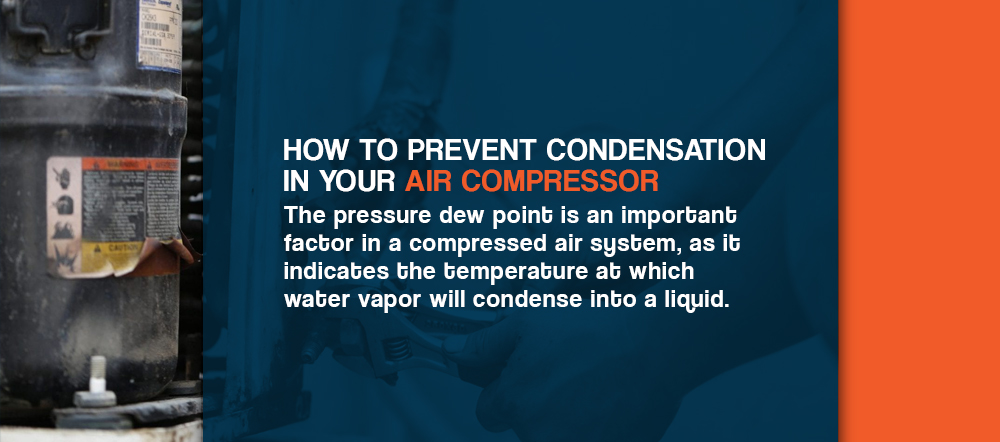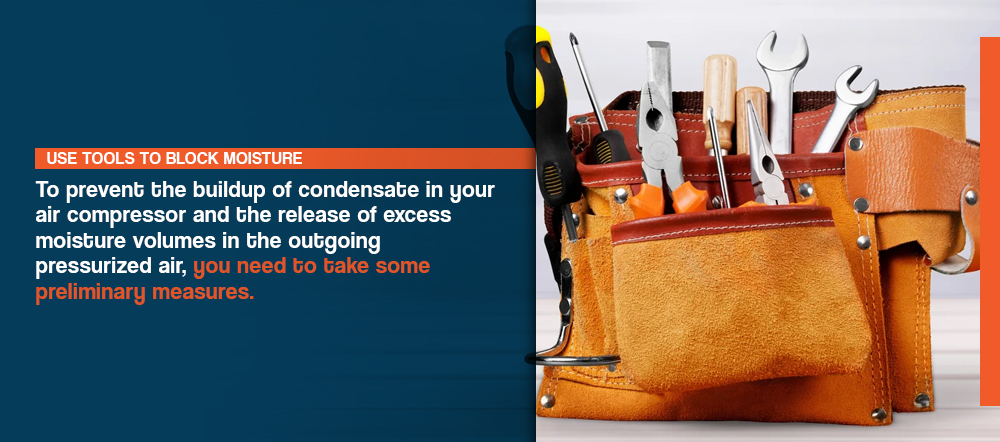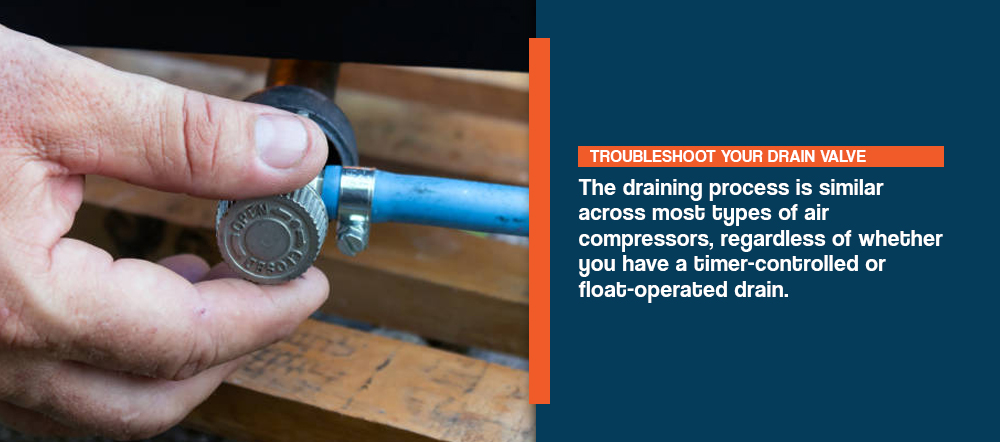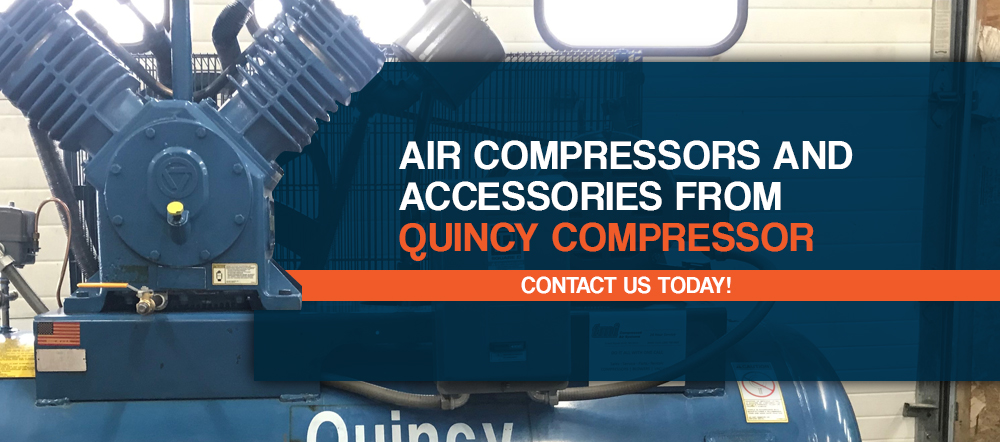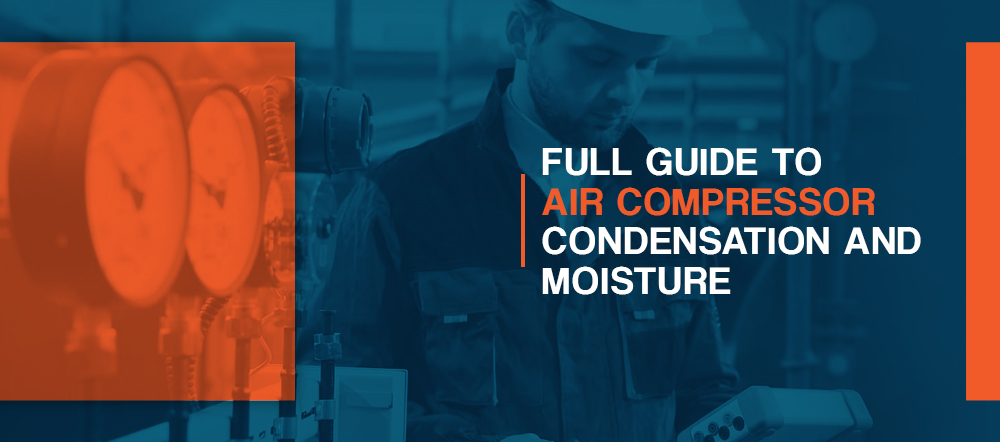
Compressed air is one of the most important utilities in a vast array of industrial applications. As a driving force behind automation and productivity, it is crucial for each air compressor to produce pressurized air that is free of moisture and other impurities. Unfortunately, not all compressors are capable of delivering quality air. The problem is due to internal and external factors, many of which are within your control as an owner. The following article covers the topic of how to reduce moisture in your air compressor lines.
Contact Us Learn More Find a Dealer Near You
Why Is There Water in My Air Compressor?
There are various reasons why air compressor condensation could come into play during the course of your operations. To reduce air compressor moisture, you need to know how to properly identify the root of the problem. If the problem is due to the failure of functions within the machine that would normally extract water from the air, you need to clean or replace those parts. If an exceedingly humid working environment is causing the problem, you need to condition the air and add drying elements to your system to remove moisture from the air compressor.
One of the most effective ways to prevent moisture in air compressor units is by using additional air dryers, which you can add to your compressor for added moisture absorption. If your compressor is in a steamy or humid environment, relocate the machine to a dryer and cooler environment, preferably indoors, if possible. The less moisture you have going through the inlet valve, the less moisture will need to be filtered out during the pressurization process.
Types of Air Compressors More Prone to Moisture
Buying an air compressor dryer can seriously help to reduce problems like condensation and moisture, but it also helps to have a compressor that is not prone to these problems. To avoid these problems in the first place, you will need to have an air compressor with sufficient capacity for the applications performed at your facility. The compressor will also need to be properly maintained on a regular basis and situated in an area with minimal moisture and humidity. Beware of moisture buildup with air compressors in the following conditions:
1. Undersized Compressor
If you are wondering what causes air compressor condensation, consider the size of the unit in relation to the applications and environment at hand. If a compressor is put under too much strain for its capacity, the internal processes will generate heat levels that could exceed the machine’s threshold. As the internal components grow hotter amid these processes, so too will each incoming supply of air.
The effects of overheating are especially common in piston compressors, which get increasingly hotter over the course of long usage cycles. If a tool or pneumatic machine is overworking the compressor, the pressurized air will inevitably contain excess volumes of moisture. The most effective way to counter the buildup of moisture is to add a separation system to your air compressor that can separate water from the pressurized air. A desiccant system can do the job as long as you monitor its condition regularly.
2. Failing Compressor
As an air compressor ages and slowly declines in its performance due to worn internal parts, you are liable to get pressurized air with higher moisture content. The problem could be especially pronounced if the unit has not undergone periodic maintenance. Overall, a failing compressor will lack the power or efficiency to extract moisture from incoming air. During a usage cycle, the internal parts of an aged compressor will heat up more rapidly, producing poor-quality compressed air.
If you pay attention to the noises and run times of your compressor, the warning signs should be obvious. A failing compressor will typically have prolonged run and fill times. The machine will also produce loud noises, especially if the model is of the piston variety. The air produced from these failing machines will generally have a moisture content that would be especially bad for dry applications like painting and sanding.
3. Compressors Used in Humid Environments
Regardless of the age, make or model of your air compressor, it could easily attract condensate and produce air with high moisture contents if you operate in an exceedingly humid environment. In hotter parts of the United States, it is generally more difficult to keep moisture levels down in a compressed air system. Therefore, if you operate a shop, garage or industrial building with controlled indoor temperature settings, you should keep all of your air compressors indoors.
For added protection from the effects of humidity in hotter climates, some operators add refrigerated air dryers to their air compressors. This helps to keep heat levels down within the unit and facilitates the separation of water from the pressurized air. For work environments where steam is an issue, desiccant air dryers are also used for further moisture absorption.
How Can Moisture Harm Your Air Compressor?
The effects of water in air compressor system parts can be damaging, costly and corrosive. If you allow condensate to accumulate inside the unit, it could gradually dry into the metal surfaces of various motor parts and cause rust. This, in turn, could cause the system to drag and eventually overheat.
To prevent damage to your air compressor and maximize its service life, you need to get rid of air compressor moisture before it accumulates inside the system. Moisture can also have a damaging effect on end-point surfaces during various pneumatic applications, especially those that require cold air. For example, if your compressor fails to extract moisture from outgoing pressurized air, the moisture could dilute paints and degrade the quality of air-drying tools.
How to Dry My Compressed Air
Ambient air contains water in the form of moisture. The purpose of an air compressor is to take ambient air and turn it into pressurized power, which can then be used to perform various functions in lieu of electric power. For this to happen, the natural air must be stripped of its moisture before it leaves the air compressor. Compressed air can be most effectively dried with the following components.
1. Water Trap and Filter Regulator
A water trap is the most basic moisture-filtering component for an air compressor. As ambient air comes into the air compressor through the inlet valve, the air passes around a bowl that extracts moisture and releases it to the drain. The newly de-moisturized air then passes into a filter where further impurities are removed.
In compressed air systems that contain a water trap, the component is used in combination with other filtering parts, which work in sequence to purify the air. This type of combination is most common in systems that are used for pneumatic processes that rely on extra-dry air, such as applications that involve airbrushes and sanding tools.
2. Refrigerated Air Dryer
Another way to prevent condensation in air compressor units is with the use of a refrigerated air dryer, which functions like an air conditioner. An air dryer connects to a compressor and conditions the air at desired temperatures. In most case, users will set the temperature within the range of 35˚F to 50˚F (1.5˚C to 10˚C), which brings the dew point (PDP) down to the range of 33˚F to 39˚F (0.5˚C to 3.8˚C). Dew point is determined by a correlation between air temperature and dryness.
During the air-drying process, moisture is extracted from the air and released to the drain. The air is then rendered warmer as it passes through the system and gets prepared for its final use in a pneumatic application. If a particular tool requires an especially low dew point, the system also needs to be equipped with a desiccant air dryer to prevent moisture from freezing inside the air compressor.
Refrigerated air dryers are manufactured in two basic types: non-cycling and cycling. Non-cycling refrigerated air dryers are designed to run continuously as long as the air compressor is active, regardless of the system demand during any given moment. By contrast, cycling air dryers conserve cold energy for use when needed. When the temperature rises to a certain level in a compressed air system, the cycling air dryer will activate. Once the temperature has been brought down to the desired level, the dryer turns back off.
Refrigerated air driers offer a method of moisture removal that is compact and exceptionally efficient.
3. Desiccant Air Dryer
Another common way to prevent moisture in air compressor units is with desiccant air dryers, which consist of tiny beads that absorb water from the incoming air. With a design and function that is similar to a water trap filter, the desiccant air dryer absorbs moisture from a compressed air system. This occurs after the air passes into a pressure vessel where water is separated through circular motion.
In most setups, desiccant air dryers are equipped with twin pressure tanks that run five-minute drying cycles, followed by five-minute regeneration cycles. Combined, these cycles form what is known as the NEMA cycle.
During the five-minute drying cycle, the newly compressed air is passed through a vessel of desiccant beads that extract the remaining moisture content from the air. Once the specified dew point is achieved, the air is sent to its final destination. During the five-minute regeneration cycle, depressurization occurs in the desiccant vessel, prompting the start of a heating process that cleans the desiccant of moisture. Once this cycle completes, the tank is repressurized for the following drying cycle.
Desiccant air dryers use one of the following three types of desiccants:
- Silica gel: made of amorphous silica for moderate dew point.
- Activated alumina: made of porous aluminum oxide and silicon dioxide.
- Molecular sieve: made of porous zeolites for select water absorption and low dew point.
Desiccant air dryers provide highly effective moisture removal in steamy work environments. As such, desiccant dryers are used most commonly in compressed air systems in factories and pressing plants.
4. Deliquescent Air Dryers
One of the less common ways to dry air compressor moisture is with the use of deliquescent dryers. These consist of one tank with desiccant beads. After the newly pressurized air passes into the tank, the desiccant creates a liquid effluent that extracts the moisture from the air. The water is then drained from the system. Deliquescent dryers offer low dew point and are therefore not typically used in factories, where the effluent could pass through the system and degrade various pneumatic applications.
5. Piping System Air Drying
Another way to reduce water in air compressor systems is with the use of a piping system. For air compressors, a piping system typically consists of long metal piping designed in an up-and-down assembly. The setup absorbs heat and lowers the air temperature. The water then passes to the bottom point of the pipes at a drip leg, where it is held temporarily. As the air continues its way through the pipes, moisture is extracted bit by bit. The sequence consists of further drip legs, with each receiving smaller quantities of water.
Piping systems are among the most low-cost ways of preventing moisture in air compressor units. As such, they are often used in compressed air systems in office buildings and by independent craftspeople.
What to Consider When Buying an Air Compressor Dryer
When you buy an air compressor dryer, make sure that it can handle the demands of your applications. Will you be operating in an environment with conditioned air, or will the unit be situated outside? Will you be operating tools that require extra dry air, or will your work consist of more conventional pneumatic functions? For example, if you plan to use your compressor in a humid environment for air-powered sanding and painting tools, you will need a higher level of protection from system moisture.
Consider also the condition of your air compressor. If it is currently in poor condition, an air dryer might not do much to remedy the problem. You will need to have a fully functional air compressor to get the maximum performance and air quality, regardless of the dryer. If your compressor is failing, it might be time to replace the machine before you consider a particular type of air dryer. Quincy compressor sells reciprocating and rotary screw air compressors in a range of sizes.
How to Prevent Condensation in Your Air Compressor
The pressure dew point is an important factor in a compressed air system, as it indicates the temperature at which water vapor will condense into a liquid. To prevent this from happening, you must maintain a low dew point.
Several factors ultimately determine the amount of condensate that develops within an air compressor. For starters, the quality of the intake air could bring higher amounts of moisture into the process if you are operating in a humid environment. The pressure levels also impact the moisture levels within your compressed air system, as does the condition of the aftercooler.
With these factors in mind, try the following strategies to help keep water out of your air compressor.
1. Use Tools to Block Moisture
To prevent the buildup of condensate in your air compressor and the release of excess moisture volumes in the outgoing pressurized air, you need to take some preliminary measures. With a water cooler in place, you can seriously reduce vapor levels from the outgoing air and ensure a cleaner, drier delivery of air to your pneumatic tools.
For additional protection from condensate and vapor, install an air dryer. Contact an air compressor dealer for more information on which components will work with your types of air compressor.
By taking preemptive measures, you can lower the amount of moisture that flows downstream in your system. Still, you should have air drying components added to your machine to enhance the drying and purification of the outgoing air. If all of your equipment and filtration components have been properly sized, yet you still see evidence of excess moisture at all of your endpoint applications, you probably have a failing condensate drain valve.
2. Troubleshoot Your Drain Valve
To maintain a functioning drain valve, you need to manually drain it on a regular basis. Without proper maintenance, the valve could accumulate condensate and gradually spread corrosion across the system. As the problem spreads downstream, the condensate could cause the air dryers to overload and also have a corrosive effect on the air receiver.
The draining process is similar across most types of air compressors, regardless of whether you have a timer-controlled or float-operated drain. In any case, it’s crucial to recognize problems when they occur so you can rectify the situation before the damage spreads to other parts of the system. Make sure that system moisture is disposed of in compliance with local environmental regulations.
To troubleshoot the drain valve, you will first need to locate it on your air compressor. The drain valve is usually located at the lowest port of the compressor tank. If the drain valve is manual, it should open when you rotate the handle. If months have passed since the valve was last drained, you will need to let it empty a sizable volume of water, after which you should hear an expansion of the compressed air from the machine. If you recently drained the valve, the air should expand the moment you open the valve.
Timer-operated and zero-loss valves are usually equipped with test buttons. Look for this feature on the faceplate. To bypass the sensing circuit and open the valve, push this button. If you hear an instant burst of air from the tank, that indicates that the drain is in good health. To drain the tank, hold the button in the open position until the process has finished, then let go of the button and allow the valve to close.
When you do any kind of troubleshooting or maintenance on your air compressor, always wear protective gear for your hands, eyes and ears. If the drain fails to work as designed, release all the pressure from the tank and close it off from the system. You will need to have the tank isolated to take out the drain valve safely. Make sure that all the air has been released before you work on the drain valve. Check the pipes and drain port for signs of sludge, dirt or corrosion. You will need to have these system parts clean before you reattach the drain valve.
Air Compressors and Accessories From Quincy Compressor
To get the most out of your air compressor, it’s crucial that the air it produces is high-quality. To help ensure high-quality air, you need to prevent excess moisture by conducting regular maintenance, controlling the workplace environment, using moisture-removing technologies and investing in superior air compressors like those from Quincy Compressor.
For nearly a century, Quincy Compressor has been the leading provider of air compressor products to customers in a range of fields. Contact the Quincy Compressor Sales and Service Representative nearest to you to learn more about our products.


